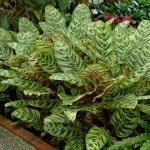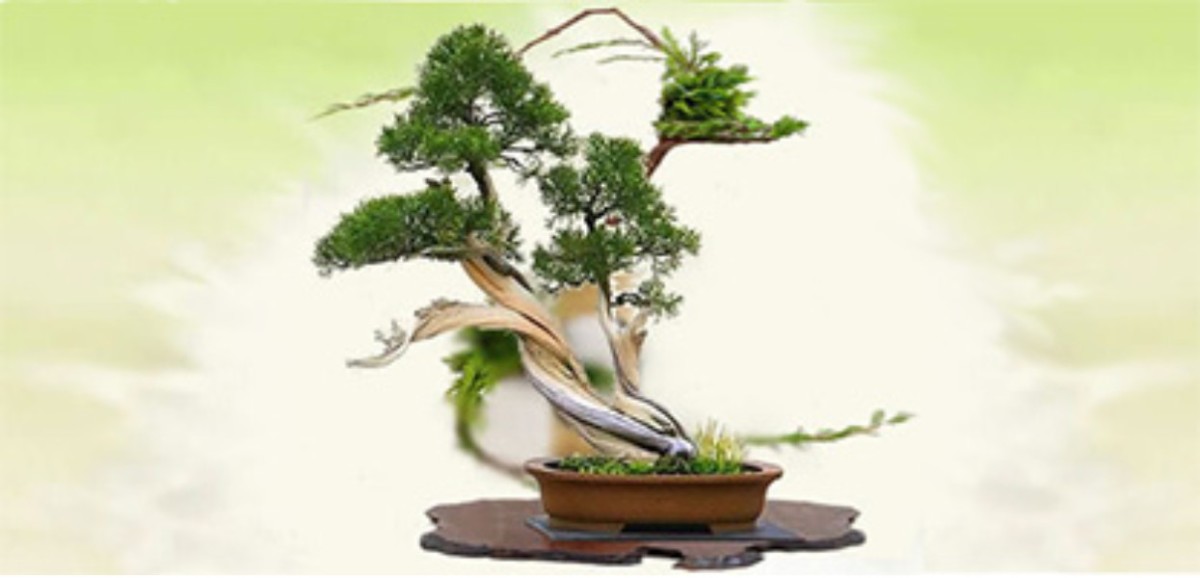Family: Marantaceae
Synonymous: Calathea olivaris
Goeppertia makoyana
Maranta iconifera
Maranta makoyana
Maranta olivaris
Phyllodes mackoyana
Distribution and habitat: Calathea makoyana is a species of evergreen perennial native to eastern Brazil, occurring in the undergrowth of the tropical forests. It grows from a thick rhizome and reaches a height of 30-50cm (12-20 inch). In their native environment, the soils are sandy and seasonally moist, not consistently wet.
Description: Calathea makoyana is a tropical plant with decorative foliage. Although the leaves may seem to rise directly from the root stock, they are normally connected to short multi-trunked or clumping stems. It has roughly oval leaves 25-30cm (10-12 inch) long on 25-30cm(10-12 inch) long stalks and they turn slightly to display the pinkish-maroon underside as well as the green upper surface. Both surfaces have very fine lines running from the central vein in a V-shape to the leaf edges, along with elliptic patches dark green on the upper surface and deep maroon on the underside. The new leaves are rolled up when they emerge and are pinkish-red on the undersides.
Flowers may be seen peeping through pale green bracks on mature plants, but they are insignificant. They are white and appear periodically throughout the year.
The Calathea makoyana plants will reach their maturity and ultimate height in an interval between 5 to 10 years.
Hoseplant care: Typically tropical, Calathea makoyana need heat and humidity and shade from direct sunlight. Remove the dying or discoloured leaves.
Light: Calathea makoyana prefers medium light - for example at a tree-shaded window. Bright light is often the cause of spoiling the foliage.
Move the plant outdoor in the spring and summer, bringing them indoors in autumn.
Temperature: A temperature ranging between 16C (60F) and 21C (70F) is ideal. In warmer rooms high humidity is essential and the foliage should be mist-sprayed daily. Rainwater is excellent for this, since it leaves no unsightly white lime deposit.
Watering: During the active growth period water plants plentifully - as often as necessary to keep the potting mixture thoroughly moist. In the rest period water moderately, enough to make the potting mixture moist, but allow the top centimetre (0.4 inch) or so of the potting mixture to dry out between waterings. Use water at room temperature.
Feeding: Calathea makoyana should be given generous amounts of standard liquid fertiliser every two weeks during the active growth period. Additional, foliar fertiliser with nitrogen or iron content can be used if the foliage colour needs improvement.
Potting and repotting: Add up to one third leaf mould or peat moss to a soil based potting mixture. In later case, however, the mixture must be kept constantly supplied with application of liquid fertiliser when plants are in active growth. Healthy plants need to be moved into pots one size larger every year - which should preferably take place in late spring or early summer.
Gardening: Calathea makoyana can be grown outdoors in warm, sheltered, frost free climate in draught-free conditions.
The dead leaves should be pruned away.
Position: Bright or direct light will cause the leaves to appear washed out. Calathea makoyana plants need shade from full sun, but can stand a little morning sun.
Very low light will cause leaf colour to pale.
Soils: Calathea makoyana thrive in well-drained acidic soils and will grow in clay, sand or loam soils as long as they are given sufficient organic material. Amend garden soil with organic matter such as compost and ground bark to enhace both drainage and water-holding capacity.
Keep the plants mulched with 3cm (1 inch) of organic matter such as ground bark. Work the mulch into the bad as it rots and replace it with fresh one.
Space the plants 30cm (12 inch) apart in beds.
Irrigation: Water only as the soil begins to dry. Water thoroughly, keep soil evenly moist to touch (not saturated). Do not allow plants to sit in water. In winter, water only when the soil becomes dry and do not soak the soil to avoid root rot.
Prepare to water outdoor plantings very regularly, using shaker hoses or dip irrigation.
Fetiliser: Feed with a liquid fertiliser every two weeks during spring and summer and once a month during autumn and winter. Do not fertilise the plant too often as overfertilising may cause leaf spots.
Propagation: In late spring divide any overcrowded clumps of Calathea makoyana, making sure that some roots remain on each part. Plant the sections in 8cm (3 inch) pots of moistened standard mixture, enclose them in plastic bags and keep them in medium light. Remove the plastic bag when the new roots have formed on the sections.
Problems:
Brown tips or edges on leaves indicate low humidity, fluoride in water or too much fertilizer.
Treatment: Increase the humidity around plants by placing the pots on trays of moistened pebbles. Use only soft water to water the plant or to spray the foliage. Flush the pot with water to wash the potting mixture from fertiliser surplus.
Plants do not thrive in low humidity where leaves may roll or brown up.
Treatment: Increase the humidity around plants by placing the pots on trays of moistened pebbles. Additionally mist-spray the plants with soft water. Water the plant adequatelly in high temperatures.
New leaves that are lighter in color are not getting enough nitrogen or iron.
Treatment: If the fertiliser does not contain nitrogen and iron nutrients, use a foliar spray that lists these nutrients on their label. Improvements should appear within a few weeks.
Calathea makoyana plants tend to be vulnerable to root rot.
Treatment: Avoid constantly wet soil. Water the plants only when necessary as recommended.
Spider mites are common plant pests of the Calathea makoyana plant. Signs of an infestation include bronzing, flecking or scorching of leaves. Once injured, the leaves will fall off and the plant may die if the infestation is not controlled.
Treatment: To control spider mites, ensure the plant has adequate water. Occasionally hose the dust off leaf surfaces to remove and kill spider mites. For heavier infestations use suitable miticides, but these do not affect the eggs and must be repeated in two-week intervals until the mites are under control.
Watch for aphids and scale insects.
Treatment: Remove the scale insects by gently scraping them off. Aphids should be removed by hand. Isolate plants that show signs of insect pest infestation to prevent infestation of other plants.
Slugs and snails may damage the beautiful foliage of these plants.
Treatment: These pests are controlled using an appropriate molluscicide, both pellet and liquid forms or by hand pick at regular inspections.
Bacterial diseases which may affect Calathea makoyana plant is Pseudomonas leaf spot.
Fungal diseaseswhich may affect Calathea makoyana plant are Alternaria leaf spot,Fusarium root rot and Helminthosporium leaf spot.
Parasitic nematodes which may affect Calathea makoyana plant are Burrowing and Root-knot.
Viral diseases which may affect Calathea makoyana plant is Mosaic.
Treatment: Prevent and treat most fungal and bacterial diseases with a broad spectrum bio-fungicide which uses a patented strain ofBacillus subtilisthat is registered for organic use. Isolate or discard affected plants to contain the diseases. Sanitize the soil and containers of the affected plants.
Note: Calatheas are closely related to marantas and species from the two genera are often confused.
Companion plants: Calathea makoyana plant is excellent in combinations withBurbidgea scheizocheila (Golden Brush Ginger) and cane Begonia species and looks sweet beneath Medinilla magnifica (Malaysian Orchids) and Rhapis excelsa (Lady Palms). It will work good when planted with Orchid, Aglaonema or Bromeliad species.
Uses and display: The handsome leaves ofCalathea makoyana plant are the attraction for tropical gardeners and indoor plant lovers as well. These warm climate plants will grow well under taller plants in their dappled shade or under trees. They will make a wonderful ground cover foliage in shaded positions.
Also, this plant is perfect for home or office if humidity can be provided. It is perfect for all kinds of containers and is very decorative on a small table or in a hanging basket. Calathea makoyana plant are mostly used for sub-tropical patio planting or as container plants. They look best when grouped with other foliage plants. Also, as these plants need high humidity and are relatively small in size, they can be used in a bottle garden or terrarium.
SUMMARY:
CHARACTERISTICS:
Foliage variegate
Shape bushy
Height: 30-50cm (12-20 inch)
Spread: 45-60cm (18-24 inch)
PROPER CARE:
Watering in rest period moderately
Watering in active growth period plentifully
Light medium
Temperature in rest period min 16C max 21C (61-70F)
Temperature in active growth period min 16C max 21C (61-70F)
Humidity high
Hardiness zone: 10a-11







